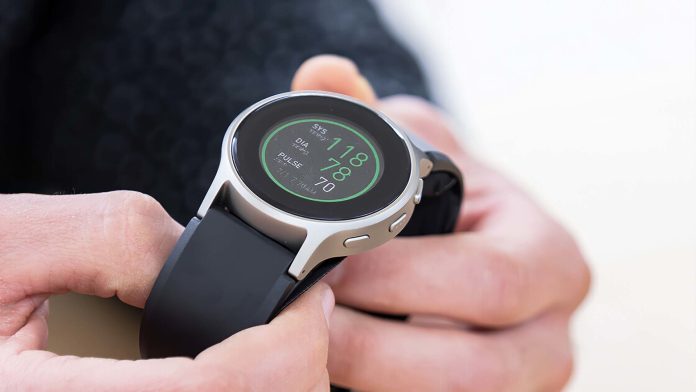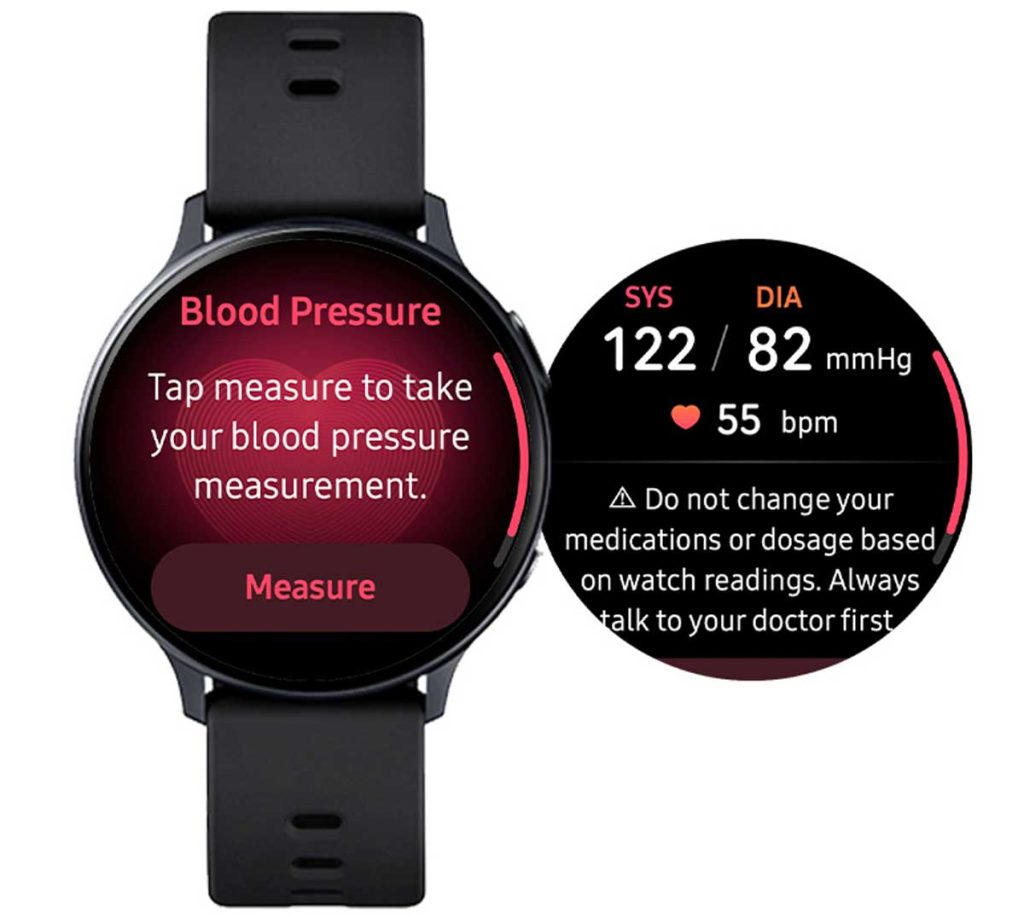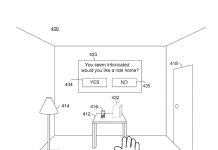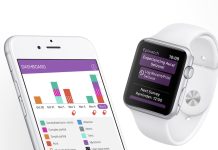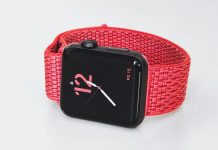Monitoring your blood pressure regularly is a routine part of maintaining your health, though the general process can be a hassle. But what if you could take a blood pressure reading wherever you are, right from your wrist?
It turns out you can. Some smartwatches offer blood pressure monitoring features, though they often come with caveats.
With that in mind, here’s what you should know about smartwatch-based blood pressure monitoring.
And remember that non of these watches are a substitute for medical advice and are not intended for detecting, monitoring, diagnosing, and treating any medical condition or disease. The measurements are for your personal reference only. So use them as one tool in your health toolkit to discuss with your healthcare team.
Contents
- 1 How does a smartwatch or cuffless system measure blood pressure?
- 2 How accurate are smartwatches for blood pressure monitoring?
- 3 What are the best blood pressure watches available today?
- 4 Samsung Galaxy Watch 5 (and earlier models)
- 5 When Will Apple Watch get blood pressure monitoring?
- 6 Meanwhile, Fitbit is busy researching how pulse arrival time can be used to measure blood pressure accurately
- 7 There may soon be another cuffless option in town — enter the Valencell fingertip device
- 8 Final thoughts
Related reading
- Apple exploring advanced sensors that could help with Blood Glucose and Blood Pressure monitoring on the Apple Watch
- Review: Withings Blood Pressure Monitor (BPM) Connect for Apple iPhone users
- Lower your blood pressure using these Inspiratory Breath Training devices (IMST)
As an Amazon Associate, we earn from qualifying purchases using links in this post.
How does a smartwatch or cuffless system measure blood pressure?

There are many ways to measure blood pressure, including invasive methods that include arterial catheterization and noninvasive procedures like oscillometry — or the cuff-based “squeezing” method you’re likely familiar with.
Smartwatches measure blood pressure in a few different ways. The Omron HeartGuide, for example, actually uses an inflatable cuff inside of its wristband to take a blood pressure reading. That means it’s more traditional than other methods.
Other smartwatches use photoplethysmography or PPG. This is a light-based optical sensor or cuff that measures a metric known as pulse transit time.
Pulse transit time is the time between a heartbeat and when a pulse arrives at a specific body part. Pulse transit time is correlated with blood pressure. The faster the transit time is, the tighter your blood vessels could be. Tighter blood vessels are a sign of higher blood pressure.
The big downside with this technology currently is that they require calibration frequently. Although PPG-based blood pressure monitors are good at measuring and tracking changes in blood pressure, they must be routinely calibrated. Samsung, for example, recommends calibrating its device at least once a month.
How accurate are smartwatches for blood pressure monitoring?
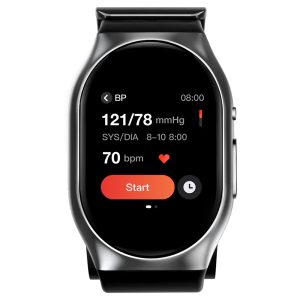
In general, most smartwatch-based blood pressure monitoring systems are not that accurate. This could change in the future, of course, but the current state of the technology just can’t compete with the industry standard.
A test of Samsung’s cuffless blood pressure measuring devices found that they were “insufficient” for medical purposes. The study, published in Frontiers in Cardiovascular Medicine, found that the device consistently overestimated low systolic blood pressures and underestimated high blood pressures.
Another study in NPJ Digital Medicine suggested that many things can affect the accuracy of these systems, including the acquisition of multiple signals, the location of sensors on the body, and other individual factors.
You can, of course, still use smartwatch-based systems for blood pressure monitoring. Just know that the results may not be up-to-par compared to the equipment found at your local pharmacy or doctor’s office.
Many companies, including Apple, Samsung, and Fitbit, are currently working on ways to improve PPG-based systems to measure blood pressure. We’ll get to some of the more recent endeavors later in this article.
In other words, you won’t want to rely solely on them. Consider using them for simple on-the-go measurements. We’d recommend buying a cuff-based system for use at home to compare their results to data produced by a more reliable device.
What are the best blood pressure watches available today?
Although smartwatch-based blood pressure monitors won’t be as accurate as traditional medical devices, they could be useful for some populations.
Because of that, we’ve identified some of the best options currently on the market. Later in this piece, we’ll also highlight some upcoming products and potential innovations.
Samsung Galaxy Watch 5 (and earlier models) 
The Samsung Galaxy Watch 5 is unique among consumer smartwatches in that it provides blood pressure monitoring (for adults 22 years and older.) It’s also a full smartwatch with deep Android compatibility, so it’s in the same vein as the Apple Watch (just for a different ecosystem).
As with most other smartwatches with blood pressure monitoring, the Galaxy Watch uses a PPG-based sensor that checks your blood pressure’s systolic and diastolic rate along with your pulse rate.
Other features of the watch include an ECG to detect heart rhythm issues, a variety of health and fitness tracking options, and a well-designed user interface.
Samsung’s line of Galaxy Watches is currently one of the only major smartwatch manufacturers that can measure both ECG and blood pressure.
Do note, however, that its blood pressure system does not work in the US at this time since it is not FDA-cleared as a medical device.
However, you can measure your blood pressure in Canada, the EU, the UK, Korea, UAE, Malaysia, and select other countries or regions where this feature is cleared by their regulatory agencies as a medical device.
To take a blood pressure reading, you must pair your watch with a Samsung Galaxy phone running (running Android 7.0 or later.) You won’t get this feature if you pair your watch with a non-Samsung Android or an iPhone.
The Blood Pressure feature works via the Samsung Health Monitor app and a cuff-type blood pressure monitor approved by a regulatory agency (like the FDA.)
The system also needs to be calibrated regularly with a blood pressure cuff (the recommendation is every 28 days) and could be more accurate. 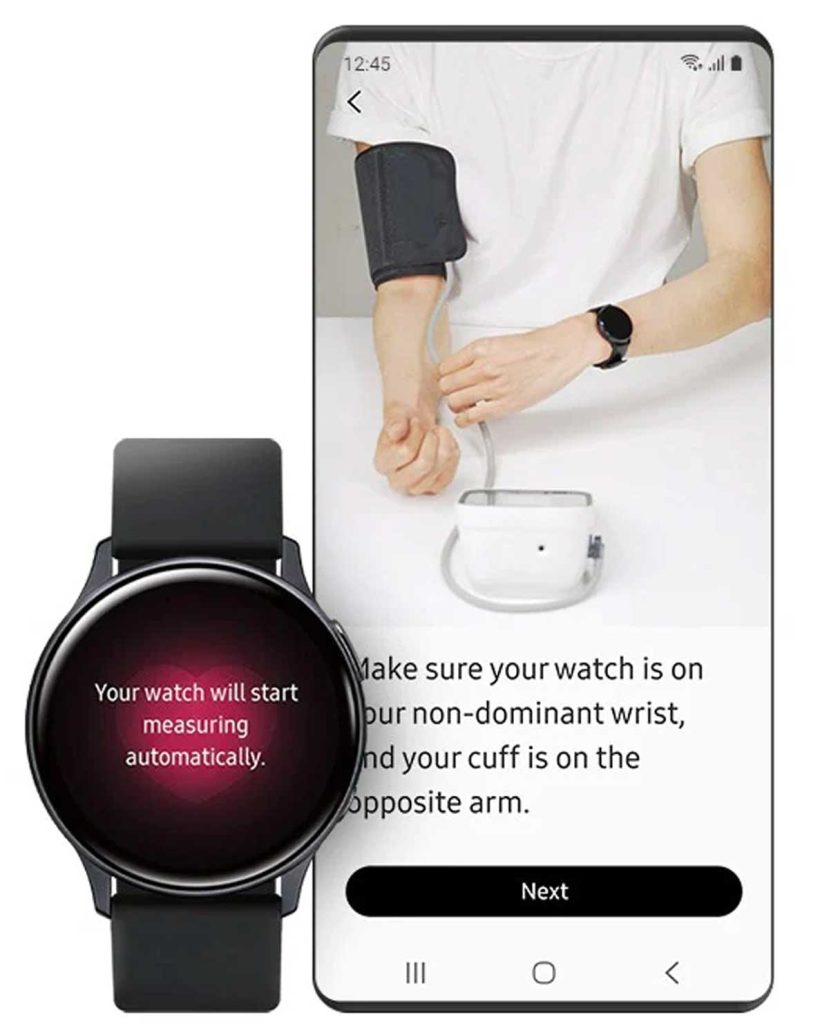
Earlier Samsung Galaxy Watches, such as the Watch 4, Watch 3, and even the Watch Active 2, can also measure your blood pressure if your country or region supports it.
- ADVANCED SLEEP COACHING: Manage your overall sleep quality with an advanced sleep tracker that...
- BODY COMPOSITION ANALYSIS (BIA): Galaxy Watch5 provides body composition data right on your wrist;...
Pros:
- It’s a full smartwatch with a ton of health and fitness features
- Cleared by many regulatory agencies around the world (but not in the US)
- Different sizing options for users
- Relatively stylish and well-designed
Cons:
- It only works with Android phones
- Battery life isn’t the best
- The blood pressure monitor is not FDA-cleared
Omron HeartGuide 
The Omron HeartGuide is a wearable blood pressure monitor that’s also an FDA-cleared wearable medical device (510K FDA clearance as a medical device.) It’s notable among smartwatches on this list because it doesn’t use a light-based PPG sensor system to measure blood pressure.
Instead, it has an inflatable cuff within its watchband that activates when you want to take a reading. 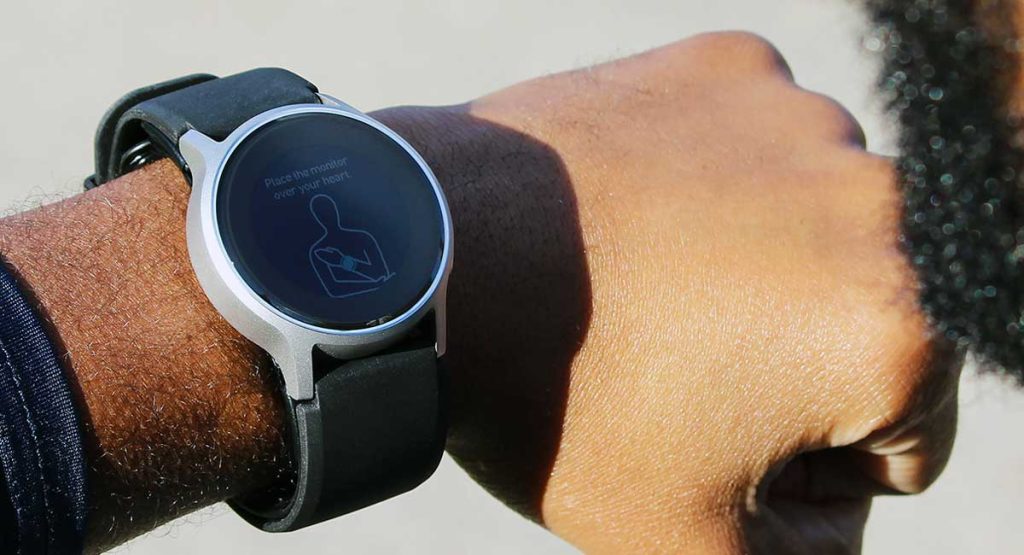
Each reading takes about 30 seconds and sends the data to a companion HeartAdvisor app. The app lets you see trends over time. It also takes into consideration variables like exercise and time of day.
While readings are speedy and more accurate than other smartwatch-based systems, a clinical study ( TY – BOOK AU – Liang, Zilu AU – Martell, Mario PY – 2020/12/18 SP – T1 – Validation of Omron Wearable Blood Pressure Monitor HeartGuide in Free-living Environments ER – ) showed that it underestimated systolic pressure and diastolic pressure. Plus, many users believe the watch is relatively large, heavy, and uncomfortable to wear. It’s also the most expensive watch on the list.
- Blood Pressure Monitor Watch: Take clinically accurate blood pressure in as little as 30 seconds
- Stay Within a Healthy Range: Monitor blood pressure and track trends over time with colored charts
Pros:
- Cleared by the FDA and other regulatory agencies
- Quick, accurate readings
- Simple display
- Fitness and sleep tracking
Cons:
- Bulky and heavy
- Price — it’s expensive
MorePro Activity Tracker
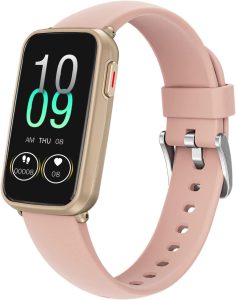
If you’re looking for more of an activity-tracking device than a smartwatch, then the MorePro Activity Tracker is a solid option that includes blood pressure monitoring. It’s also the cheapest option on this list.
Along with a PPG blood pressure sensor, the activity tracker also sports sensors like a pedometer, blood oxygen monitoring system, and GPS. It’s also a small, lightweight device that you might forget you’re wearing.
Although it’s compatible with Android or Apple phones, you should expect only partial smartwatch functionality. This is more of an old-school Fitbit than an Apple Watch, and the display is relatively small.
This device isn’t cleared by a regulatory agency and is intended for personal reference only.
- Embark on your journey toward a healthier, more vibrant you with the Newest Fitness Tracker from...
- Why Choose the MorePro Fitness Tracker? - Its advanced sensors provide a wealth of insights to help...
Pros:
- Affordable for what it offers
- It has a wealth of health and fitness trackers
- Small and lightweight
Cons:
- Small display
- Won’t provide full smartwatch capabilities
- Blood pressure monitor is not cleared by regulatory agencies like the FDA
FitVII Smartwatch
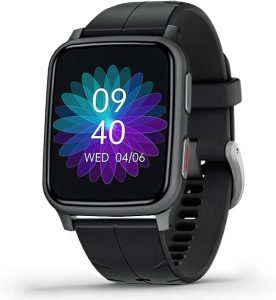
Those looking for a more affordable option might consider the FitVII Smartwatch. It’s produced by a Chinese health and fitness technology company and is very affordable compared to other smartwatches.
Like most other smartwatches, the watch uses an optical sensor to provide on-the-go blood pressure monitoring. It won’t be the most accurate, but many users say it’s surprisingly on par for such an affordable device.
Along with blood pressure, the watch also tracks blood oxygen SpO2, heart rate, workouts, and other metrics you’d likely want on a fitness tracker. It isn’t, however, the most durable or stylish of the watches on this list.
This device isn’t cleared by a regulatory agency and is intended for personal reference only.
- Fitness Monitoring: Know your body better by using FITVII smart watch all day fitness monitoring....
- Advanced Sleep Monitor: Track your awake, light, and deep sleep time and gauge blood oxygen...
Pros:
- Very affordable
- Additional fitness and health features
- Surprisingly accurate
Cons:
- Not stylish or durable
- Quality control concerns
- Expect very little customer service
- Blood pressure monitor is not cleared by regulatory agencies like the FDA
YHE BP Doctor Pro Blood Pressure Smartwatch
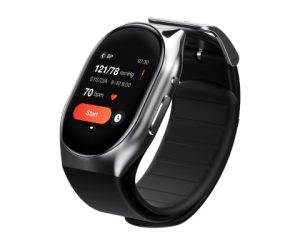
The YHE BP Doctor Smartwatch is another option for smartwatch-based blood pressure monitoring. It’s one of the better options on the market if you don’t want to wait for improved technologies from Apple, Fitbit, or Samsung.
The company was founded by former Mindray, Withings, and Misfit employees and, at this time, only produces medical-grade smartwatches centered on blood pressure and health monitoring.
Like the Omron HeartGuide, this watch uses an inflatable cuff to take blood pressure readings, which is generally more accurate than optical sensors. It’s a solid option if you want on-the-go blood pressure monitoring with some basic smartwatch functionality.
Speaking of which, this is no Apple Watch or Galaxy Watch. You’ll find minimal capabilities beyond sleep tracking, walk tracking, and run tracking. The YHE BP Doctor Smartwatch doesn’t track other fitness routines and lacks GPS functionality.
This device isn’t cleared by the FDA or a regulatory agency and is intended for personal reference only.
It retails for $199 on the company’s website.
Pros:
- Accurate blood pressure monitoring
- Good build quality
- Walk, run, and sleep tracking
Cons:
- Poor battery life
- Won’t provide a full suite of fitness features
- No GPS capabilities
- Blood pressure monitor is not cleared by regulatory agencies like the FDA
When Will Apple Watch get blood pressure monitoring?
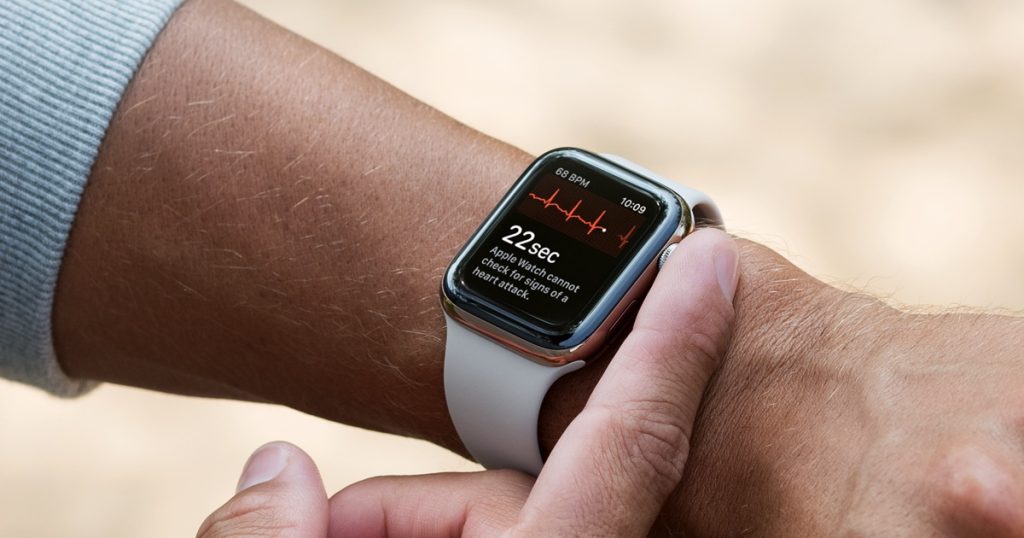
Current Apple Watch models don’t have any blood pressure monitoring capabilities, but there’s a high probability that this won’t be the case forever.
Reports from Bloomberg and other media outlets indicate that the Cupertino tech giant is currently exploring adding a blood pressure monitoring feature on a future Apple Watch.
These rumors suggest that the feature, which is being tested on employees, won’t tell a user their systolic or diastolic blood pressure readings. Instead, it would scan this data in the background and only alert users if it detects signs of hypertension.
Once it does potential hypertension, the system would tell them to see a doctor or use a regular blood pressure monitoring cuff.
The most recent rumors indicate that the company is targeting 2024 for a potential launch. However, the feature has been planned for at least four years, and the timeline could change. Although a working version might hit the market in two years, Bloomberg notes that the launch date could slip to 2025.
Rumors of Apple’s development of the Apple Watch blood pressure monitoring systems appear to reinforce what medical studies have told us. Reportedly, Bloomberg notes that accuracy has been a “challenge” during internal testing of Apple Watch blood pressure monitoring technologies.
Meanwhile, Fitbit is busy researching how pulse arrival time can be used to measure blood pressure accurately
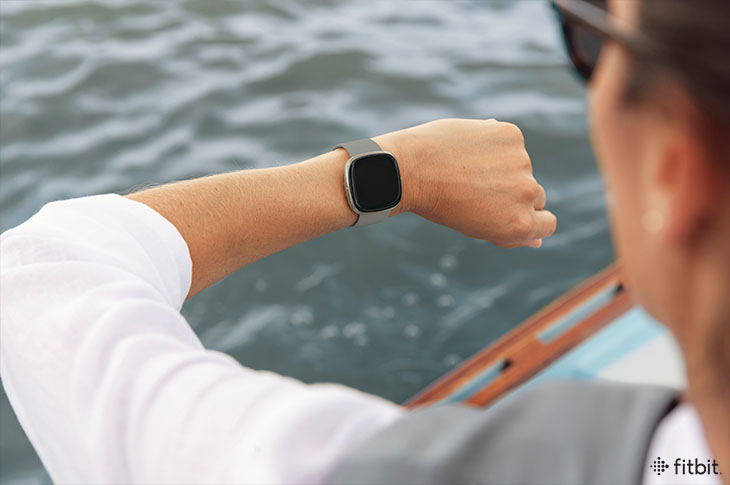
Fitbit is another major player in the consumer health tech market, and you may be wondering what the Google-owned company is up to when it comes to blood pressure monitoring. In a word: research.
Back in 2021, the company launched a study to determine how to use pulse arrival time to accurately measure blood pressure on its smartwatches. Specifically, the study recruited Fitbit Sense users over 20 years old to determine if pulse arrival time can be linked to blood pressure readings.
Although past studies have shown a correlation between pulse arrival time and blood pressure, it wasn’t strong enough to indicate that the former metric could predict the latter.
In other words, while other companies are already using this time of technology for at-home blood pressure readings, Fitbit is trying to back its approach with data. By recruiting current Fitbit users, the company potentially has a large dataset to use in its research.
Given that Google now owns Fitbit, the study could lead to the addition of a science-backed system on a future wearable. Currently, however, Fitbit doesn’t have any blood pressure monitoring features on its wearables.
Samsung is rethinking its blood pressure monitoring approach on Galaxy Watch 6
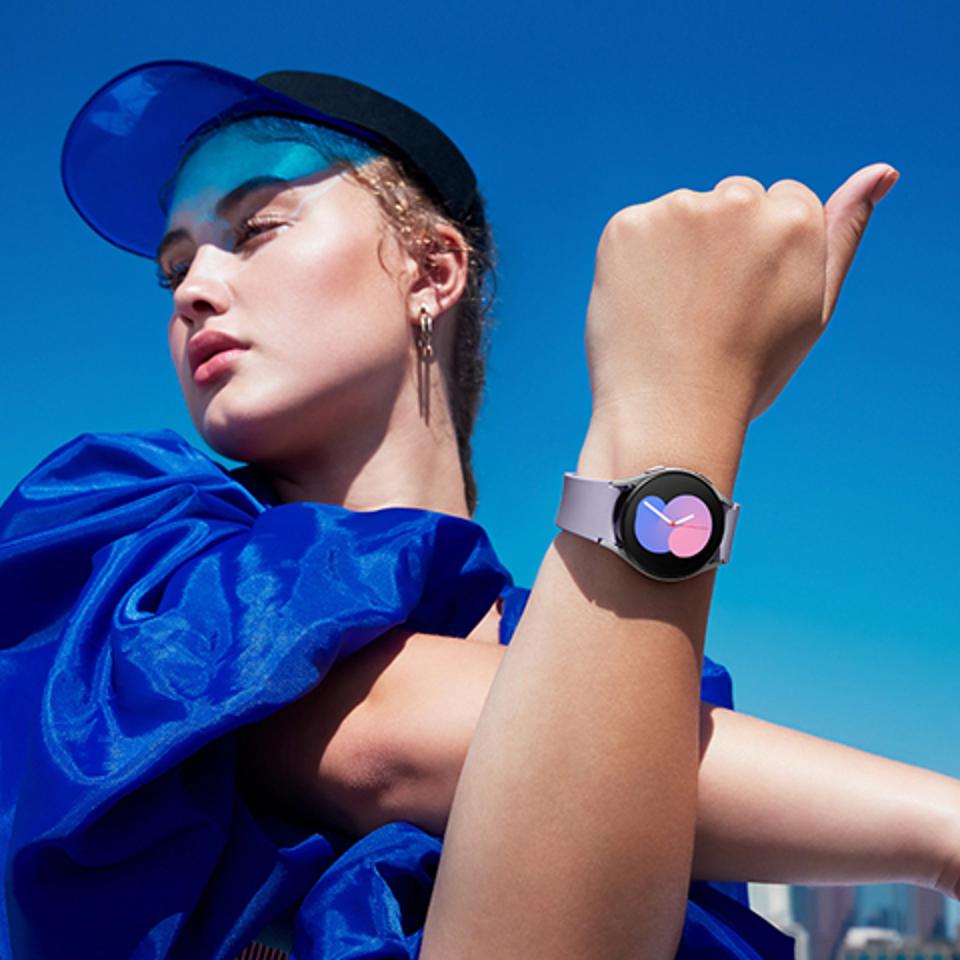
As we’ve detailed, smartwatch-based blood pressure monitoring systems leave a lot to be desired in terms of accuracy. While Apple is working on its own proprietary design, Samsung is also rethinking its approach.
A patent application first spotted by MyHealthyApple in December indicated that the South Korean tech giant is looking to improve its PPG-based system by adding an inertial force sensor.
This force sensor would be configured to measure a force applied by a finger to the PPG system. New information provided by this pressure would be combined with the existing PPG sensor to better estimate systolic and diastolic blood pressure readings.
According to the patent, the system uses applanation principles by way of measuring the magnitude of pulsatile force. It also would be less prone to influence from external factors like body temperature.
Per the patent, the new design could help the watch estimate various metrics, including blood pressure, vascular age, and arterial stiffness.
There may soon be another cuffless option in town — enter the Valencell fingertip device
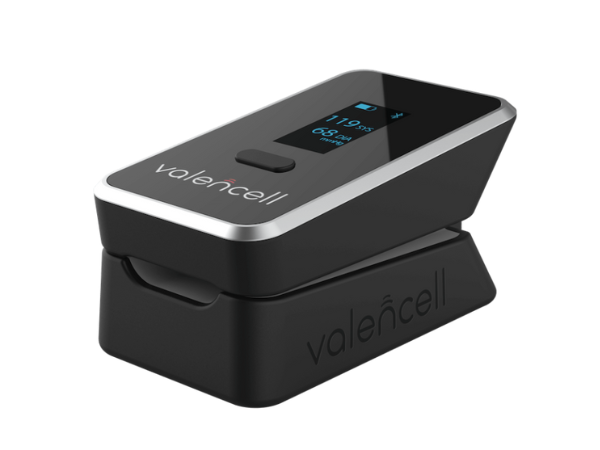
If you’re not necessarily in the market for a new smartwatch, then current at-home options for blood pressure monitoring are generally cuff-based. However, that could soon change with the introduction of the Valencell fingertip blood pressure monitor.
Valencell is a company specializing in producing sensor technology and algorithms to read data produced by them. With its fingertip device, the company expects to release the first cuff-free, calibration-free consumer blood pressure monitoring system.
Like many smartwatch-based platforms, the system uses PPG technology to read blood pressure. A user places their finger within the device, and Valencell’s PPG sensor reflects light to measure blood pressure.
Unlike many current iterations of PPG technology, Valencell has years of experience ensuring its readings are as accurate as possible. The company has engineered new AI-based algorithms trained on a 7,000-person data set. This algorithm analyzes a user’s age, weight, height, and gender to provide the most accurate reading possible.
Because the device is unreleased, there isn’t a wealth of user testing on its accuracy. It’s also awaiting FDA clearance before it can hit the market. In the meantime, it certainly sounds like a promising device that can improve PPG-based tech.
Final thoughts
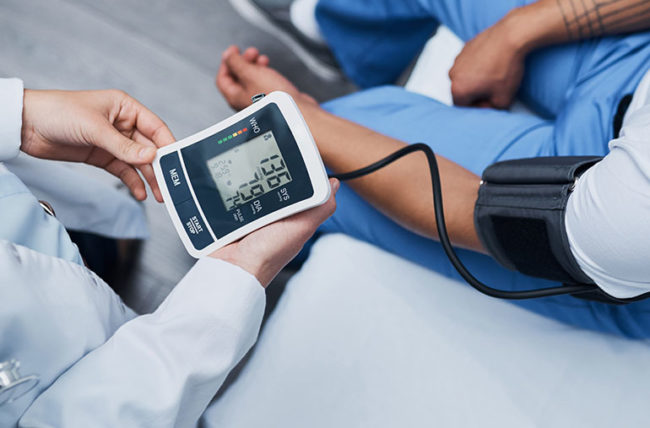
As we’ve seen, there are several different blood pressure-monitoring smartwatches out there–some have regulatory approval, while most don’t (especially the more affordable options.) Although they vary in price and quality, they generally won’t provide the same level of blood pressure accuracy as a more traditional medical device.
Because of that, we recommend smartwatch-based blood pressure monitors as a secondary option to a smart cuff-based system.
There are plenty of smart blood pressure monitoring cuffs readily available in the consumer market. These smart devices connect to your phone and offer tracking apps that integrate with your phone’s health app, including Apple Health, Samsung Health, and Google Fit.
- 3 Best Blood Pressure Monitors to use with Apple’s Health app
- 4 best blood pressure monitors that work with the Samsung Health app
- 4 best Google Fit-compatible blood pressure monitors
Still, blood pressure smartwatches may be a good buy for those with high blood pressure. Being able to take a blood pressure reading while you’re out and about can certainly come in handy.
For most other people, they’re simply not going to be accurate enough for regular blood pressure readings. The fact that you have to calibrate most of them also complicates matters.
If you don’t need a blood pressure monitor on your wrist at all times, we recommend waiting until the technology improves.
We sometimes use affiliate links in our content from Amazon and others. It doesn’t cost you anything but helps us pay our expenses. Thank you for the support! Last update on 2024-04-18 / Affiliate links / Images from Amazon Product Advertising API

